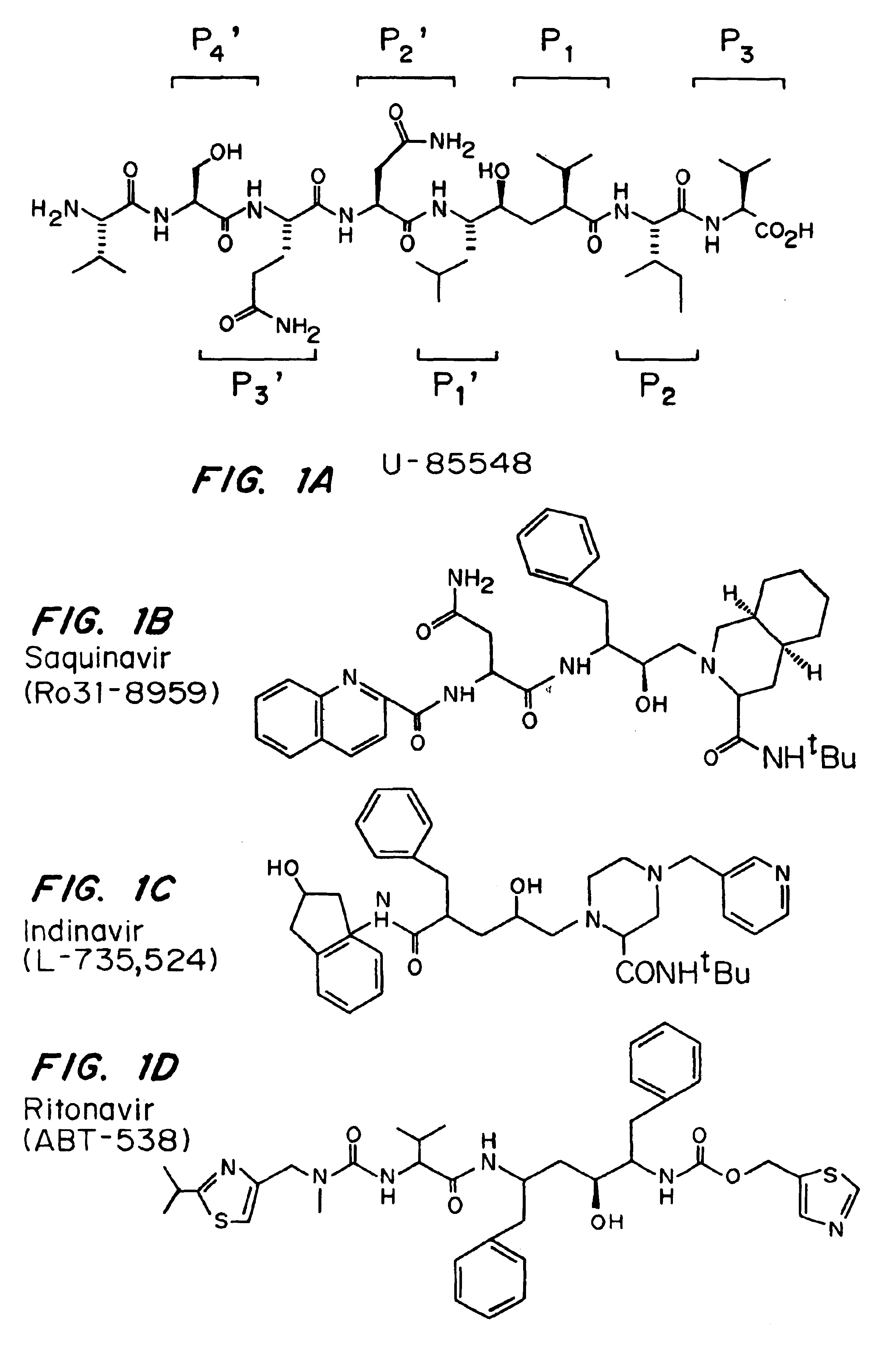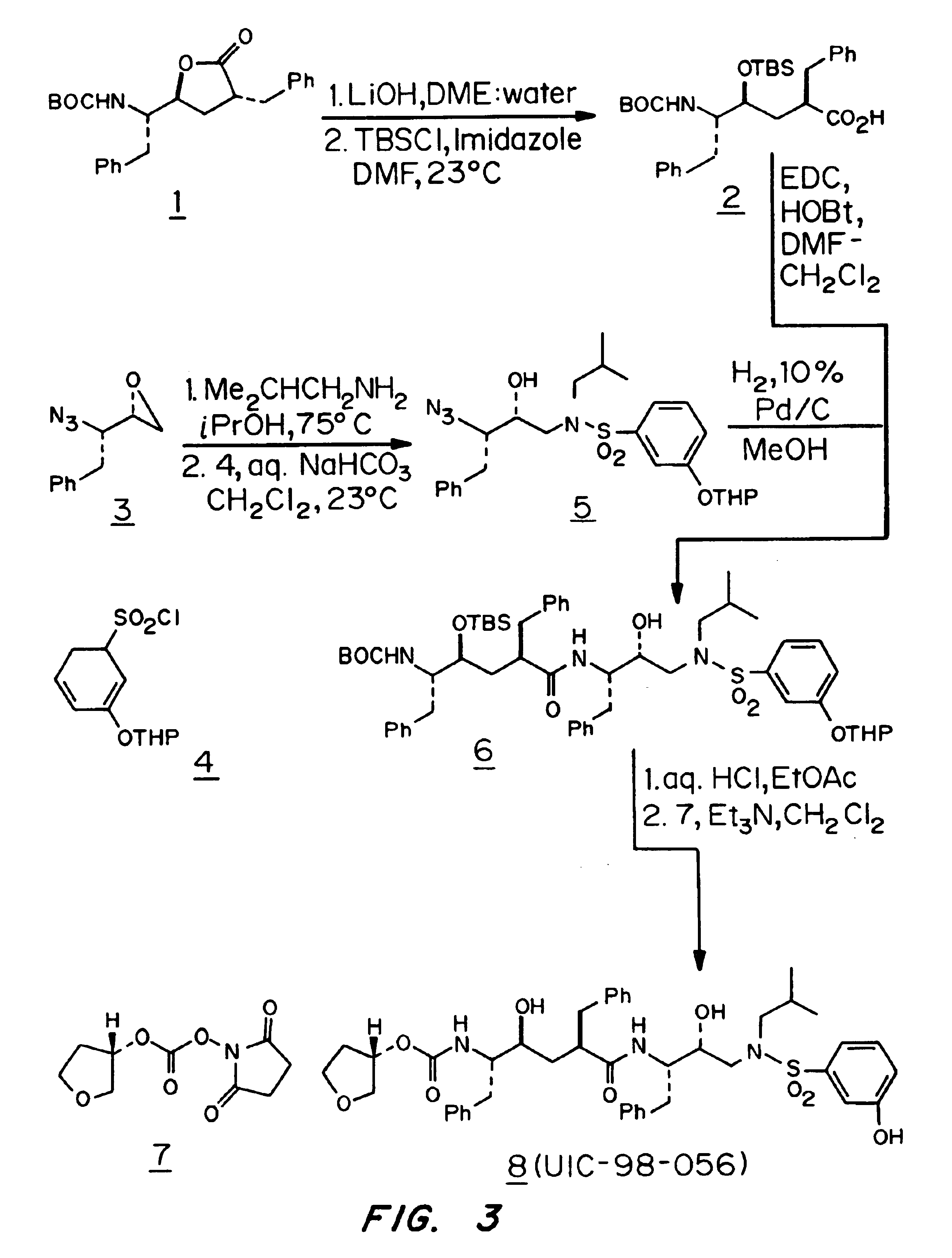Protease inhibitors that overcome drug resistance
a technology of protease inhibitors and resistance, applied in the field of protease inhibitors, can solve the problems of extremely rapid mutation of virus, and achieve the effect of less prone to resistance and better activity
- Summary
- Abstract
- Description
- Claims
- Application Information
AI Technical Summary
Benefits of technology
Problems solved by technology
Method used
Image
Examples
example 1
Design and Synthesis of Two-isostere HIVPr Inhibitor UIC-98-056
[0045]Based on the principle described above and other considerations, HIVPr inhibitor UIC-98-056 was designed and synthesized. The structure of this inhibitor is shown in FIG. 2.
Synthesis of HIV Protease Inhibitor UIC-98-056
[0046]The synthesis of HIV protease inhibitor UIC-98-056 with hydroxyethylene and hydroxyethylamine isosteres is outlined in FIG. 3. The known lactone 1 was converted to acid 2 by lithium hydroxide mediated hydrolysis followed by protection of the alcohol functionality as tert-butyldimethylsilyl ether (Ghosh et al., 1998, Synthesis, 937 (Review); Ghosh et al., 1991, J. Org. Chem. 56:6500; Evens et al., 1985). The previously described (Ghosh et al., 1992, J. Chem. Soc., Chem. Co., 273; Ghosh et al., 1998, Synthesis, 937 (Review)) azido epoxide 3 was reacted with isobutylamine in 2-propanol at 80° C. for 4 h and the resulting azidoalcohol was treated with m-tetrahydropyranyloxybenzenesulfonyl chloride ...
example 2
Demonstration that Inhibitor UIC-99-056 Can Withstand Resistance
[0052]The inhibition constant, Ki, of UIC-98-056 was determined for the wild type HIV-1 protease and 10 mutants resistant to HIVPr inhibitors using the methods described by Ermolieff et al. (1997), Biochemistry 36:12364-12370. The wild-type HIV-1 Pr was produced as recombinant enzyme in E. coli as described by Ido et al. ( 1991) J. Biol. Chem. 266:24359-24366. The mutant enzymes were made by site-directed mutagenesis of the HIVPr gene either as described by Ermolieff et al., 1997, Biochemistry 36:12364-12370 or by a similar procedure. These mutants were identified in clinical trials and in vitro studies to resist saquinvair (mutants G48V and L90M, Jacobsen et al., 1996, J. Infect. Diseases 173:1379-1387), indinavir (mutants V82A, M46I and L10I, Condra et al., 1995; Lander, Richman and Vella (1998) HIV Resistance and Implications for Therapy MediCom.) and ritonavir (mutants L90M, V82A, K20R and M46I, Molla et al., 1996, ...
PUM
| Property | Measurement | Unit |
|---|---|---|
| structure | aaaaa | aaaaa |
| Drug resistance | aaaaa | aaaaa |
| drug resistance | aaaaa | aaaaa |
Abstract
Description
Claims
Application Information
 Login to View More
Login to View More - R&D
- Intellectual Property
- Life Sciences
- Materials
- Tech Scout
- Unparalleled Data Quality
- Higher Quality Content
- 60% Fewer Hallucinations
Browse by: Latest US Patents, China's latest patents, Technical Efficacy Thesaurus, Application Domain, Technology Topic, Popular Technical Reports.
© 2025 PatSnap. All rights reserved.Legal|Privacy policy|Modern Slavery Act Transparency Statement|Sitemap|About US| Contact US: help@patsnap.com



